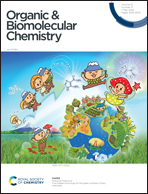New 2-pyridone-based donor–acceptor dyes: the effect of the donor group position, type of π-linker and acid–base characteristics of the medium on the photophysical properties†
Abstract
A series of novel donor–acceptor pyrid-2-ones was synthesized. The influence of the donor group on the photophysical properties of chromophores in solution was shown by varying the methoxy group position in the electron-rich aromatic ring. The effect of the π-linker was also demonstrated by the comparison of the D–π–A pyridone with its spacer-free analogue (D–A) and with the chromophore bearing an additional thiophene bridge (D–π–π–A). It was found that the presence of a π-linker plays a crucial role in the implementation of an intramolecular charge transfer (ICT) from the donor aryl moiety to the pyridone acceptor. Thus, for the synthesized D–A, D–π–A and D–π–π–A derivatives, the photoluminescence quantum yield in DMSO solution decreases from 56.8 to 4.3 and 3.5%, respectively, along with a strong bathochromic shift both for absorption (66 nm) and emission (162 nm) bands. Also, the possibility of shifting the equilibrium in DMSO solution towards either the pyridone form or the anionic form by the addition of a strong acid (TFA) and base (DBN) respectively was shown. Drastic changes in the photoluminescence of the solutions showed prospects for the application of the synthesized donor–acceptor pyridone derivatives as naked-eye acid–base indicators in organic media.



 Please wait while we load your content...
Please wait while we load your content...